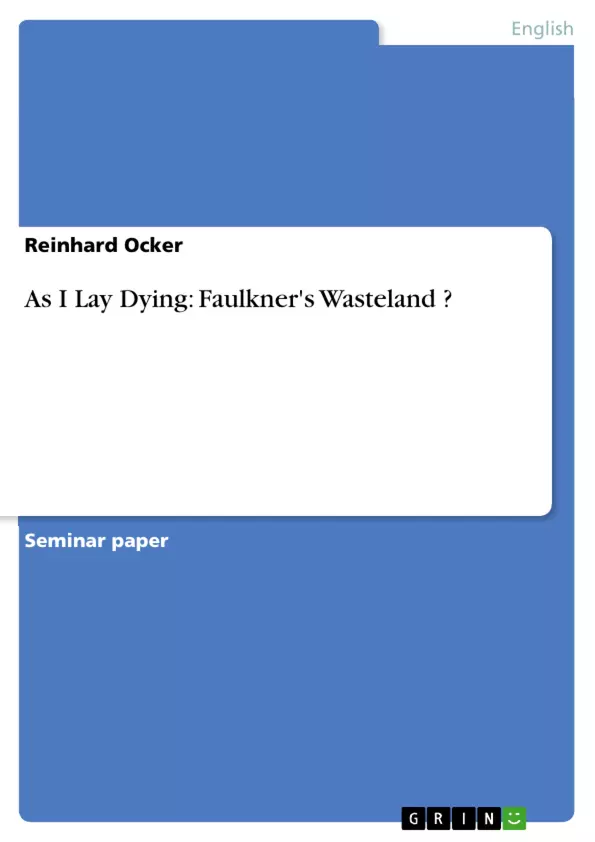It is a well-known fact that Faulkner in his work made extensive use of what T.S. Eliot had established as ′the mythological method′. Like Eliot, he used the old myths in his narrations as an underlying human structure which yielded depth and meaning to his work and a certain kind of continuity of basic human virtues and vices. This was especially important in a time of general post-war disillusionment which, of course, affected deeply the literary conventions and styles of the time.
The debate of how much exactly Faulkner drew upon Eliot is held ever since the first book of Faulkner was published. It is considered probable that Faulkner knew the vegetation myths of Frazer and there can be hardly any doubt that Faulkner knew The Wasteland and the discussion of its sources. Unimportant and futile though it might therefore be to add another shabby brick to the impressive building of Faulkner criticism, I think it could be fun to once more oppose two outstanding works of Faulkner and Eliot in a close reading and see whether we can find a formerly neglected relation.
I believe that the influence of The Wasteland (including some of its most important sources; i.e. The Golden Bough by Sir James George Frazer and From Ritual to Romance by Jesie Weston) on As I Lay Dying works on different levels.
First on a literal - symbolic level.: Faulkner employs in a more or less unobtrusive way quite a few symbols or images of The Wasteland: April, Spring, New teeth, Gramophone, Fish, chuck, chuck, chuck (the sound of the adze) vs. Jug jug jug jug , five children, an abortion, several paraphrases (set my land in order vs. set my house in order)
Second on a level of atmosphere: Faulkner evokes through his dense and powerful prose the gloomy and portentous atmosphere of The Wasteland.
Third on a level of narration: The Wasteland is a patchwork of a multitude of different voices which are stringed together in the seer-like character of Tiresias.
So is As I lay dying. It is a patchwork of many voices which at first sight seem to be all equal to each other as far as the narrational standpoint is concerned. In a closer reading, however, one realizes that Darl relates events that he possibly cannot know, for he is not on the scene.
In the following I′d like to elaborate the above mentioned in more detail.
Inhaltsverzeichnis (Table of Contents)
- Introduction
- The literal - symbolic level of the relation
- Relation of Atmosphere
- Relation of Narration Structure
- Conclusion
Zielsetzung und Themenschwerpunkte (Objectives and Key Themes)
This paper aims to analyze the influence of T.S. Eliot’s “The Waste Land” on William Faulkner’s “As I Lay Dying.” The paper will explore the various levels on which Faulkner employed the mythological method established by Eliot, specifically the literal-symbolic, atmospheric, and narrative levels.
- The literal-symbolic level: Exploring how Faulkner utilizes specific symbols and images from "The Waste Land" in "As I Lay Dying."
- The atmosphere level: Examining how Faulkner evokes the gloomy and portentous atmosphere of "The Waste Land" through his prose.
- The narrative level: Comparing the fragmented, multi-voiced narrative structure of "The Waste Land" to that of "As I Lay Dying."
- The influence of other works: Highlighting the potential influence of sources such as "The Golden Bough" by Sir James George Frazer and "From Ritual to Romance" by Jesie Weston on both "The Waste Land" and "As I Lay Dying."
- The significance of symbolism: Analyzing the symbolic weight of specific objects and events, such as the false teeth and the gramophone, within both works.
Zusammenfassung der Kapitel (Chapter Summaries)
- Introduction: This chapter establishes the context of the paper by outlining the influence of "The Waste Land" on Faulkner's work and the debate surrounding the extent of that influence. It also introduces the argument that a close reading of both works reveals a formerly neglected relationship.
- The literal - symbolic level of the relation: This chapter explores the literal correspondences between “As I Lay Dying” and “The Waste Land,” focusing on specific symbols and images shared by both works, such as the gramophone, teeth, and the recurring sounds “chuck, chuck, chuck” and “jug jug jug.”
Schlüsselwörter (Keywords)
The main keywords and focus topics of the text include: William Faulkner, T.S. Eliot, “The Wasteland,” “As I Lay Dying,” mythological method, symbolism, atmosphere, narrative structure, fragmented narrative, “The Golden Bough,” Jesie Weston, and influence.
- Quote paper
- Reinhard Ocker (Author), 2001, As I Lay Dying: Faulkner's Wasteland ?, Munich, GRIN Verlag, https://www.hausarbeiten.de/document/9919


